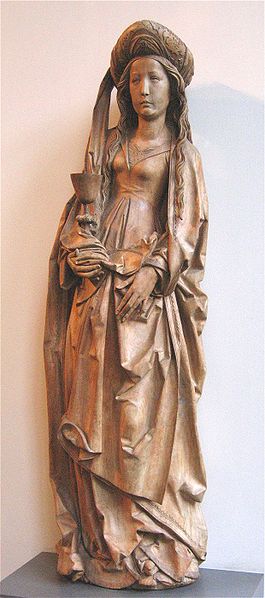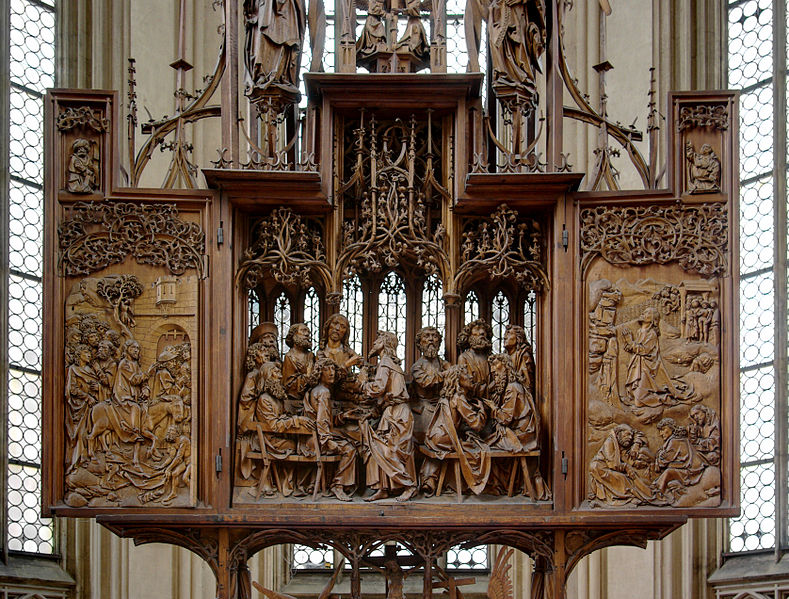The Sculpture of Tilman Riemenschneider, written by Christopher Blum
 Here is a second in a series about late gothic sculpture. This one is written by Dr Christopher Blum and appears in Crisis Magazine (http://www.crisismagazine.com). You can find the article itself here. One of the questions that I always think about as an artist when I see work that I enjoy is how could we train artists today to work in a similar way today. How does an artist learn to make this style his natural modus operandus. Dr Blum is a historian and his interest is as much on the spirit of the times as the technical skill of the artist. He describes the training and working environment that Riemenschnieder experienced, and focussed particularly on his membership of his town's Guild of St Luke. When guilds are mentioned nowadays there tend to be two reactions. For some it conjures up images of a culturally rich past that we hardly dare dream of emulating today. For others, they are professional organisations that flourished by imposing restrictive trade practices, rather like strident medieval trade union. For my own part, I prefer to put aside the possible negative aspects of the economic organisation of the guilds, and focus on how these associations preserved the attitude of tradition by preserving skills and creating structured environment to train apprentices and which directed their activities activities to the common good. Here is an article that has some thoughts about how the guilds might be a model for the teaching of practical skills today. As a general principle, when considering any aspect of the culture, we should always aim, I feel, to adopt the good and reject the bad.
Here is a second in a series about late gothic sculpture. This one is written by Dr Christopher Blum and appears in Crisis Magazine (http://www.crisismagazine.com). You can find the article itself here. One of the questions that I always think about as an artist when I see work that I enjoy is how could we train artists today to work in a similar way today. How does an artist learn to make this style his natural modus operandus. Dr Blum is a historian and his interest is as much on the spirit of the times as the technical skill of the artist. He describes the training and working environment that Riemenschnieder experienced, and focussed particularly on his membership of his town's Guild of St Luke. When guilds are mentioned nowadays there tend to be two reactions. For some it conjures up images of a culturally rich past that we hardly dare dream of emulating today. For others, they are professional organisations that flourished by imposing restrictive trade practices, rather like strident medieval trade union. For my own part, I prefer to put aside the possible negative aspects of the economic organisation of the guilds, and focus on how these associations preserved the attitude of tradition by preserving skills and creating structured environment to train apprentices and which directed their activities activities to the common good. Here is an article that has some thoughts about how the guilds might be a model for the teaching of practical skills today. As a general principle, when considering any aspect of the culture, we should always aim, I feel, to adopt the good and reject the bad.
Dr Blum makes the interesting point that this somber gothic style with its focus on the suffering of Christ was not reflective of the artist's personal character. In other words, 'self-expression' was not one of the aims of the artist (in the way that the phrase is generally used today). It would be wrong however, to think that conformity to the spirit of the times and a tradition ruled out innovation or individual stylisation altogether. What is different here is that that innovation is driven by a desire to serve the stated end, the glorification of God, in a better way, rather than to glorify the artist. As an example, in contrast to the French sculptures described in the last article, here, which were brightly coloured, . Even though they are made of wood, they had a monochrome brown glaze, which was very unusual at the time.
Images are St Barbara and the Last Supper.
